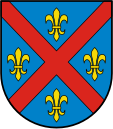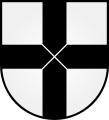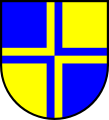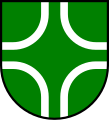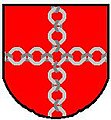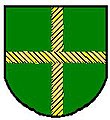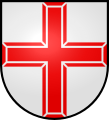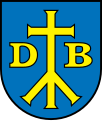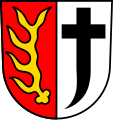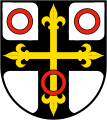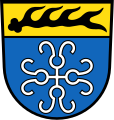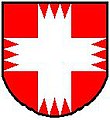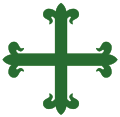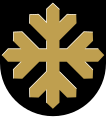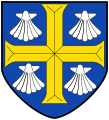Cross (heraldry)
The cross is used in great variety in heraldry and exists in many variants. As a common figure, the cross floats freely in the coat of arms . If the four arms of the cross touch the edge of the coat of arms, it is called a herald's image . There are many varieties of the basic form, the common cross , and this often gives the cross a new name. It can be any color . The description of the coat of arms should give every detail.
Appearance and function
The name of the cross is based on two criteria: its appearance and its function. For example, a pointed lily cross or glaive cross (appearance) is called a sign of the order of St. Jacob (function) Jacob's cross .
basic forms
The common cross , sometimes referred to as a bar cross , is understood to be a bar crossed with a stake , in which everything is represented in a tincture and without continuous lines. The common cross is (as the name suggests) the general basic form of the heraldic cross and a common herald image in heraldry. The Greek or shortened cross is a cross with particularly short bars, which is considered an independent cross in ecclesiastical and political heraldry.
The second common form is the Latin cross (high cross, passion cross) with the elongated lower arm.
Upright with pole and beam is the normal form, the X position is the inclined cross (St. Andrew's cross, sloping cross) .
- See also: Squared cross (a bar or St. Andrew's cross in a square)
Crosses with a lower crossing arm formed as a point are named after the main shape with the addition -steckkreuz or - pointed cross . Here the common cross with a point pointing downwards would be a bar-type cross .
Heraldic variations
Are modifications, for example the edging (rimmed), the aperture ((broken), chess division geschacht ) and faceting (faceted). A cross can have other figures on it. The boundary lines can have different designs due to the coats of arms .
Cross as a common figure
In the coat of arms / field or as a gem , the cross has significantly influenced heraldry . While in the aforementioned group the cross served to split the coat of arms, as a common figure it is to be treated like other figures. The most diverse forms can be found in the coats of arms: They often express the religiousness or religious affiliation of the bearer of the coat of arms. It is difficult to assign the different names for the same cross shape. The uniqueness of the coat of arms description is decisive. The crosses can floating , pierced , surrounded , supported by an animal or human figure, or even with things ( roses , lilies , hearts and other things more) has to be. Hats , crowns can float above the cross or be hung on the arm . For church dignitaries, crosses placed behind the coat of arms are a matter of course. In church heraldry , rules have emerged over the centuries for each level of church dignity.
Cross as a herald image
The common cross is the exit for this group. It occurs when a post and a beam cross in the middle without a dividing line in the same color at a right angle . As agreed, the four arms of the cross must touch the edge of the coat of arms as a “herald image”. All other forms can be derived. The cross arms can take on all shapes, only the ends of the arms cannot necessarily be changed. Many cross shapes so derived are based on the crest section (Astschnitt, Clear cut, battlements section) and Herold images displayed on them ( geschacht , riveted, ground, squared, faceted, square, pierced, rimmed, occupied and died change), respectively.
Examples
| image | Basic form | description | example |
|---|---|---|---|
|
|
Dew cross | Antony Cross, Old Testament Cross, Egyptian Cross . Formed from a central post and shield head . |
|
|
|
Göpel | Has the shape of an inverted Y- shape or a fallen drawbar. |
|
|
|
Drawbar ( fork cross , Schächerkreuz) |
Has the shape of a Y. |
|
|
|
#Common cross | The simple horizontal-vertical cross, in the variants Greek cross and Balkenkreuz . |
|
|
|
Latin cross | Hochkreuz (Passion Cross); today's typical cross of Christianity with the extended foot beam. From a central post and a beam shifted towards the upper edge of the shield. |
|
|
|
Crosshair | Narrow stake and beam form a common cross. If several threads (posts or bars) are parallel, their number is important for the designation: twin thread, triple crosshair. Are woven the threads, and their distance is not substantially greater than its width, creating a Flechtgitterkreuz . | |
|
|
split ( pole ) and split ( beam ) cross |
The colors of the halves are different. If the cross is placed diagonally, one describes ( emblazoned ) a split or divided slant cross . | |
|
|
vertically separated and horizontally divided cross |
Separation by a different colored thread. If both separations occur in a picture, this figure is called gammadium . |
|
|
|
nimbly cross | The center of the cross is the center of a circle. | |
|
|
squared cross | The center of the cross is the center of a square. | |
|
|
broken and pierced cross | Common cross with a square or round opening. |
|
|
|
Rod cross | The common cross has only half the contour width. | |
|
|
Support arch cross | The fillets at the point of intersection of the pile and beam are rounded. One example of this is Hermsdorf (Thuringia) . |
|
|
|
Paw cross | The cross arms are widened. |
|
|
|
St. Andrew's Cross | ( Oblique cross , Schragen ): The cross is rotated 45 degrees in the coat of arms. |
|
|
|
Celtic cross , wheel cross | Bar cross, often with an extended support bar (Latin cross), around the cross point a ring (see also: Chatschkar ) |
|
|
|
Wheel cross | Wheel cross (" sun wheel ") |
|
|
|
Swastika , swastika, snake cross | Swastika - cross with angled or bent arms (Latin crux gammata , gammadion ) |
|
|
|
Three-bar cross | # 1 St. Andrew's cross with a vertical pole, # 2 Hagal cross (ᚼ), # 3 Christos monogram Chi - Rho ( ☧ ), # 4 Iota - Chi cross, # 5 bar star (6 points) |
|
|
|
Four-bar cross | # 1 dome cross (common cross placed on a St. Andrew's cross), # 2 cross of Constantine , # 3 bar star (8 points) |
|
Individual forms of the cross
- Abbreviated cross : see Greek cross
- Paragraph cross : see threshold cross
- Eight-pointed cross : see Maltese cross
-
 Egyptian handle cross : Antoniuskreuz
Egyptian handle cross : Antoniuskreuz
-
 Egyptian cross : also Antonius cross, tau cross
Egyptian cross : also Antonius cross, tau cross -
 Alcantara and Calatrava Cross
Alcantara and Calatrava Cross - Alpfuß , Alpkreuz : Pentalpha
-
 St. Andrew's Cross : also inclined cross , sloping , Sicilian cross
St. Andrew's Cross : also inclined cross , sloping , Sicilian cross
-
 Anchor chain cross : Two chains form a cross.
Anchor chain cross : Two chains form a cross. -
 Anchor cross : The cross arms are shown with flared tips
Anchor cross : The cross arms are shown with flared tips -
 Armenian cross:
Armenian cross: -
 Apple cross : The cross arms are equipped with small balls (apples). The cross is also called a pilgrimage cross or a piston cross.
Apple cross : The cross arms are equipped with small balls (apples). The cross is also called a pilgrimage cross or a piston cross. -
 Branch cross : The cross arms are shown with natural or stylized branches made of gnarled tree trunks horizontally / vertically.
Branch cross : The cross arms are shown with natural or stylized branches made of gnarled tree trunks horizontally / vertically. -
 Balkenkreuz : common cross
Balkenkreuz : common cross - Bale cross: apple cross , less separated
-
 Buttoned key cross:
Buttoned key cross: - Bernward Cross : A cross with square ends
- Flower cross :
- Burgundy cross: branch cross, lies as a St. Andrew's cross
-
 Byzantine Cross : Cross with widening cross ends
Byzantine Cross : Cross with widening cross ends - Calvarius Cross : Passion Cross
- Order of Christ cross : see crutch cross , cruciform cross
- Drawbar : fork cross, Schächerkreuz
-
 Trident cross : The ends of the arms run out as a trident .
Trident cross : The ends of the arms run out as a trident . -
 Double cross: see Patriarchal Cross , Lorraine Cross
Double cross: see Patriarchal Cross , Lorraine Cross
-
 Triple crosshair : common cross formed from threads
Triple crosshair : common cross formed from threads - Continuous cross :
- Crosshair : thread-like narrow arms, common cross
-
 Window cross : square with four square openings, in the square there is a common cross
Window cross : square with four square openings, in the square there is a common cross - Braided cross : Common cross made of thin threads that appear to be braided
-
 cross with ripped feet
cross with ripped feet -
 Forked cross : Cross with two, usually three, forks
Forked cross : Cross with two, usually three, forks -
 Goosefoot :
Goosefoot : -
 forked cross, see also toothed cross
forked cross, see also toothed cross -
 Common cross : Balkenkreuz
Common cross : Balkenkreuz - Travel Cross : Trident Cross
- Göpel : The cross has the shape of an overturned Ypsilon.
-
 Greek cross
Greek cross
- Handle cross : see ancient Egyptian cross
- High cross : from a central post and a beam shifted towards the upper edge of the shield
- Hochmeisterkreuz : German Masters Cross. Silver rod cross with gold lily ends and an eagle shield gold / black
-
 Jacob Cross : fußgespitztes lily cross (glaives) as a religious symbol of St. Jacob
Jacob Cross : fußgespitztes lily cross (glaives) as a religious symbol of St. Jacob -
 Jerusalem cross : five crosses symbolize the five wounds of Christ .
Jerusalem cross : five crosses symbolize the five wounds of Christ . -
 Yoke cross : common cross with round incisions
Yoke cross : common cross with round incisions -
 Johanneskreuz : cross arms only widen at the end
Johanneskreuz : cross arms only widen at the end - Cardinal Cross: Patriarchal Cross
-
 Trefoil cross : Three-leaf cross, Lazarus cross, St. Thomas cross
Trefoil cross : Three-leaf cross, Lazarus cross, St. Thomas cross -
 Knotted cross : post and beam are braided through a square (vertical shape).
Knotted cross : post and beam are braided through a square (vertical shape). - Knot cross post and beam are braided through a square and rotated 45 degrees
- Contour cross: see shadow cross
-
 Crutch cross : with small crossbars as arm ends
Crutch cross : with small crossbars as arm ends -
 Ball cross : The arms consist of balls .
Ball cross : The arms consist of balls . -
 Ball bar cross: see also pilgrim cross
Ball bar cross: see also pilgrim cross -
 Latin cross or passion cross
Latin cross or passion cross -
 Lily cross or lily end cross
Lily cross or lily end cross -
 Lily scepter cross
Lily scepter cross -
 Linden leaf cross: common cross with cross arms made of stylized linden leaves .
Linden leaf cross: common cross with cross arms made of stylized linden leaves . -
 Lorraine cross : cross with two bars
Lorraine cross : cross with two bars -
 Maltese cross : Johanniterkreuz
Maltese cross : Johanniterkreuz -
 Marian Cross : Cross on or next to an M.
Marian Cross : Cross on or next to an M. -
 Wall anchor cross
Wall anchor cross
-
 Mill cross: anchor cross, common cross with barbs on the arms
Mill cross: anchor cross, common cross with barbs on the arms -
 Mill iron cross
Mill iron cross -
 Pope Cross : Pontifical Cross ; three arms that become shorter towards the top
Pope Cross : Pontifical Cross ; three arms that become shorter towards the top -
 Part cross : a common cross with outwardly widened cross arms that taper off in a semicircle.
Part cross : a common cross with outwardly widened cross arms that taper off in a semicircle. -
 Passion cross : see Latin cross
Passion cross : see Latin cross
- Patrick's Cross : symbol of St. Patrick; red cross on white
-
 Peterskreuz : Petrus Cross , inverted Latin cross
Peterskreuz : Petrus Cross , inverted Latin cross -
 Pole cross :
Pole cross : -
 Graft cross:
Graft cross: -
 Philippus cross : lying Latin cross
Philippus cross : lying Latin cross -
 Pilgrim cross : see also ball-stick cross
Pilgrim cross : see also ball-stick cross -
 Paw cross : arms of the same length, cross arms only widen at the end
Paw cross : arms of the same length, cross arms only widen at the end -
 Quest cross : common cross with a ring of the same color around the middle
Quest cross : common cross with a ring of the same color around the middle -
 Wheel cross : cross in a circle
Wheel cross : cross in a circle -
 Ring cross : common cross, there are rings on the arm ends
Ring cross : common cross, there are rings on the arm ends -
 Round nail head cross: common cross with protruding semicircles
Round nail head cross: common cross with protruding semicircles -
 Schächerkreuz : also tau cross , drawbar
Schächerkreuz : also tau cross , drawbar
-
 Checkered Cross: common cross with a checkerboard pattern
Checkered Cross: common cross with a checkerboard pattern - Shadow cross : Representation of a common cross only through thin boundary lines
-
 Shadow mill iron cross
Shadow mill iron cross -
 Snake cross
Snake cross
- Schragen : see St. Andrew's Cross
- Diagonal crosshair : slant cross, arms are narrow
- Floating cross
-
 Scandinavian cross : according to the heraldic right lying Latin cross
Scandinavian cross : according to the heraldic right lying Latin cross - St. Thomas Cross : see also clover leaf cross
-
 Thick cross : also cross, pointed cross at the bottom
Thick cross : also cross, pointed cross at the bottom -
 Cane cross
Cane cross - Step cross :
-
 Fir cross: Common cross, the arms of which are stylized fir branches.
Fir cross: Common cross, the arms of which are stylized fir branches. -
 Paw cross
Paw cross
-
 Tau cross : crossbeam on a longitudinal beam
Tau cross : crossbeam on a longitudinal beam -
 Tetragram cross: Greek cross with fire steels in the angles
Tetragram cross: Greek cross with fire steels in the angles -
 Tolosan Cross or Occitan Cross
Tolosan Cross or Occitan Cross -
 Teardrop cross : teardrop-shaped arms
Teardrop cross : teardrop-shaped arms -
 Trysub : symbol in the Ukrainian coat of arms , similar to the trident
Trysub : symbol in the Ukrainian coat of arms , similar to the trident -
 People's cross : in the round field a common cross (Italy)
People's cross : in the round field a common cross (Italy) -
 Volute cross: common cross with rolled arms at the ends of the cross
Volute cross: common cross with rolled arms at the ends of the cross -
 Weckenkreuz :
Weckenkreuz : -
 Consecration cross : also crux signata, papal cross or apostles cross, modification of the patriarchal cross
Consecration cross : also crux signata, papal cross or apostles cross, modification of the patriarchal cross -
 Wiederkreuz : common cross with arms on arms
Wiederkreuz : common cross with arms on arms -
 Cloud cross
Cloud cross -
 toothed cross, toothed cross
toothed cross, toothed cross -
 Cane cross
Cane cross -
 Twin crosshairs : cross made from two parallel threads
Twin crosshairs : cross made from two parallel threads
Gallery - crosses as a herald image
red paw cross
continuous red St. Andrew's cross (Schragen)
Quest Cross (Quest)
Peterskreuz, Petruskreuz
Gallery - crosses as a common figure
Wheel cross in the coat of arms of Aukrug
Pointed nail head cross or arrow cross
buttoned broken key cross; Tolosan Cross
Lily cross as a cross by Avis
Cloud cross , inclined as a coat of arms of Lombardy
Web links
literature
- Walter Leonhard : The big book of heraldic art. Development, elements, motifs, design. 2nd, revised and expanded edition. Callwey, Munich 1978, ISBN 3-7667-0345-5 .
Individual evidence
- ↑ Adam Breysig: Dictionary of Imagery or brief and instructive details of symbolic and allegorical images and often conventional signs mixed with them. Friedrich Christian Wilhelm Vogel, Leipzig 1830, p. 45 .
- ↑ Gert Oswald : Lexicon of Heraldry. Bibliographical Institute, Leipzig 1984.







